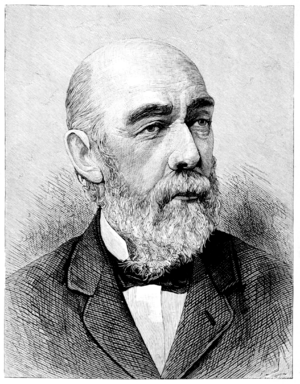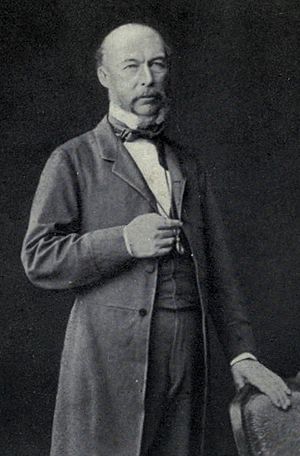James Fergusson (architect) facts for kids
Quick facts for kids
James Fergusson
FRS
|
|
|---|---|
 |
|
| Born | 22 January 1808 |
| Died | 9 January 1886 (aged 77) |
| Resting place | Highgate Cemetery |
| Parent(s) |
|
James Fergusson (born January 22, 1808 – died January 9, 1886) was a Scottish historian. He is best known for studying old buildings, especially those in India. He helped people in the 1800s learn more about ancient India. Even though he wasn't formally trained as an architect, he designed some buildings and decorations. He was also a member of the Royal Society, a famous group of scientists.
Contents
Life and Work
Early Life and India
James Fergusson was born in Ayr, Scotland. His father, William Fergusson, was an army doctor. James went to school in Edinburgh and then in Hounslow, England.
Later, he moved to India to work for his family's trading company in Calcutta. While there, he became very interested in the old buildings and ruins of India. At that time, not many people knew much about them. After about ten years, he had enough money to stop working in business and move back to London.
Studying Architecture
James Fergusson wrote many important books about architecture. His first book about Indian buildings was called The Rock-cut Temples of India, published in 1845. These were temples carved directly into rock.
He then wrote a bigger book called The Illustrated Handbook of Architecture in 1855. This book looked at different building styles from all over the world and from different time periods. He later expanded this work into a three-volume series.
He also wrote a special book just about Indian architecture. It was called The History of Indian and Eastern Architecture, published in 1876. This book helped many people understand the amazing old buildings of India.
Work in the United Kingdom
In 1849, Fergusson wrote a book about art and beauty, especially in architecture. He also had ideas about how light was used in ancient Greek temples.
James Fergusson was also concerned about Britain's safety. He wrote books and essays about how Britain could defend itself from possible attacks. He was part of a special group that suggested building many forts along the coast. These forts became known as "Palmerston's Follies".
He received a special award, the gold medal from the Royal Institute of British Architects, in 1871. He wrote other books too, including ones about the ancient city of Nineveh, the Mausoleum at Halicarnassus, and old stone monuments.
Though he didn't design many buildings, some of his work still exists. These include the parliament building in Jamaica and the Marianne North Gallery at Kew Gardens in England.
Fergusson also helped with the design of the Assyrian court at The Crystal Palace. He even worked as a general manager for the Crystal Palace Company for two years. He also advised on the design of the Royal Albert Hall, a famous concert hall in London.
Theories about Jerusalem
James Fergusson had some interesting ideas about the ancient city of Jerusalem. He believed that the building known as the Mosque of Omar was actually a church built by Constantine the Great over the tomb of Jesus. He thought this was the true burial place of Jesus, not the church that is known as the Holy Sepulchre today. He wrote several books explaining his theories about Jerusalem. His ideas helped start the Palestine Exploration Fund, a group that studies the history and geography of the Holy Land.
James Fergusson passed away in London on January 9, 1886. He is buried with his father in Highgate Cemetery.
Selected Publications
- Fergusson, James. An historical inquiry into the true principles of beauty in art, more especially with reference to architecture (1849).
- Fergusson, James. An Essay on a Proposed New System of Fortification: with Hints for its Application to our National Defences (1849).
- Fergusson, James. The Illustrated Handbook of Architecture (1855).
- Fergusson, James. Tree and Serpent Worship, or Illustrations of Mythology and Art in India (1868).
- Fergusson, James. Rude Stone Monuments in all countries (1872).
- Fergusson, James. History of the modern styles of architecture (1891).
- Fergusson, James, et al. 'History of Indian and Eastern Architecture, 2nd Edition (1910).
Images for kids



